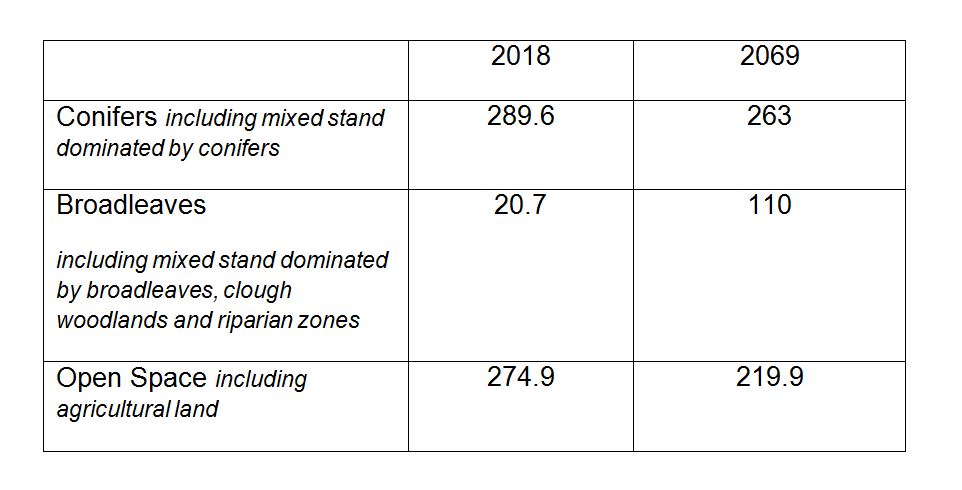Dark Peak Forest Plan
About
The Dark Peak Forest Plan (FP) summarises proposals by the Forestry Commission for the management of three woodlands, Snake (154.2ha), Lockerbrook (191ha) and Westend (240.2ha) which lie in the Peak District National Park, Derbyshire. The plan area of 585.4ha lies mid-way between Glossop and Sheffield adjacent to the A57, Ladybower and Derwent Reservoir.
The woodlands are dominated by productive mature conifer forest much of which is 70-90 years old and ready for harvesting. The new management plan objectives will be to continue to grow commercial crops on a sustainable basis, diversify the forest structure through harvesting operations, restore native clough woodland, expand the woodland boundaries to develop move open mixed stands designed to increase unity with open moorland and show an increase in visual ‘naturalness’ in the long term.
The principal ecological interest in the plan area is a combination of moorland, native woodland habitats and fauna associated with it. The FP will help to develop a wider range of woodland habitats through active forest management. This will be achieved specifically through the retention of some strands of trees in perpetuity, the development of mixed open stands along water courses and the interface with the surrounding open moorland, restoration of clough woodland and increased length of woodland edge habitat. Recent felling operations have already begun to increase the available nesting site for birds.
The Forestry Commission will continue to provide open access throughout all of the FP woodlands to the millions of visitors who come into the National Park each year. The two waymarked trails will be maintained and the woodland management adjacent to these will be carried out at an appropriate scale.
Objectives
The main objectives for the Dark Peak Forest Plan are:
Economic
- Continue production of commercial conifers and broadleaves.
- Make the economic potential of the forest more resilient in the face of a changing climate.
- Utilise natural regeneration to form part of the next rotation.
Environmental
- Manage the open habitats for upland vegetation, breeding birds, invertebrates, using grazing where possible.
- Restore Clough woodland sites.
- Identify, retain and recruit Trees of Special Interest.
- Diversify forest structure and tree species.
Social
- Allow free and open access throughout the woodlands under the FC Open Access policy.
- Manage the 2 waymarked trails in Snake wood and work in partnership with the local landowners and National Park authority to promote the area for leisure and tourism.
- Conserve and enhance surviving elements of the historic environment within the forest landscape.
What we will do
The plan details management operations including approved felling and restocking for the 10 years through until 2028, with outline proposals for a 50 year period.
Active harvesting programmes will begin in some of the more mature stands with a selection of individual and small groups of trees been retained to become future trees of special interest. When stands are restocked the upper tree line will be lowered from the surrounding moorland plateau allowing an irregular open stand of trees to develop. This will be dominated by broadleaves on the upper slopes moving into mixed stands and then conifer dominated stands on the lower slopes.
The open habitats now been grazed and cut will be monitored to establish any improvement in biodiversity and new areas of Clough woodland will be created through a combination of excluding grazing, enrichment planting and natural regeneration.
The planned areas of clearfelling, restocking and permanent open space creation during the ten years to 2028 are summarised in the table.
In addition 89ha will be managed as Low Impact Silvicultural Systems (LISS). This will be done through a thinning operation, removing no more than 40% of the stems within any single management unit/ compartment over the plan period. This operation will include; encourage initial seeding, provide sufficient light to boost growth of understorey and ground flora, allow adequate space for the development of crowns and stem form for quality timber and accelerate individual tree growth. This operation will also be supported, where needed by; supplementary planting in order to increase species diversity. In addition to these defined operations, ongoing thinning and of both conifers and broadleaves will be carried out in the plan area at five to ten year intervals.
The proportions of open space, conifer and broadleaf woodland at the beginning of the plan period are shown in the bar chart.




